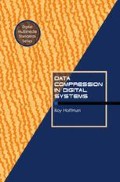Abstract
Chapters 7 and 8 describe how data compression is used in communications. For many communications applications, bandwidth conservation is an important reason to use data compression. It can increase the effective throughput of existing transmission channels or, alternatively, reduce transmission costs by allowing lower-speed or shared transmission facilities to be used. Equally important in some applications, data compression can reduce transmission time. Various combinations of lossless and lossy compression are used in communications, with most algorithms being specially adapted for the transmission channels and the data being transmitted on those channels. For each application, we will examine the communications system and the compression algorithms that are appropriate. This chapter deals with applications where voice, data, images, and video are transmitted on communications networks. Chapter 8 describes broadcasting applications.
Access this chapter
Tax calculation will be finalised at checkout
Purchases are for personal use only
Preview
Unable to display preview. Download preview PDF.
Notes
Lines are designated as low-, medium-, and high-speed according to discussion in this section. All transmission protocols, the rules that govern data transmission, introduce some hopefully small overhead for routing data and assuring reliable transmission, and there will be delay, unless the line happens to be idle.
For that matter, all adaptive algorithms must pass synchronization information and all assume the transmission will be error-free.
Technology for moderas operating at 56 Kbps exists [Wall96]. Actually, most users may not see much benefit if faster modems come to market. Today’s 28.8-Kbps modems often are forced to operate at far less than their rated speed because of the noise on analog telephone lines. Modems that attempt to push to higher data rates will face increasing noise limitations.
High-speed transmission protocols that use fast-packet multiplexing include frame relay where variable-size packets are transmitted and cell relay protocols such as SMDS and ATM, where small, fixed-size packets are transmitted.
See the discussion of variable bit-rate coding in Section 5.2.
There are also gateways for connecting two computer networks that use entirely different communications architectures. Depending on whether incoming and departing messages are compressed or not, gateways may use data compression as they transfer information from one network to the other.
To take advantage of the high data rates and low error rates of modern transmission facilities, broadband technologies such as frame relay eliminate error checking and correction at low levels, moving the function closer to the end users [Davi94, Stal94B].
Wireless LANs are a different story. Their bandwidths are much lower, making data compression more feasible, and their usage is spreading, making it more desirable. As a result, one might speculate that data compression technology could someday be adapted to wireless LANs.
However, there are situations where broadband transmissions must be sent over lower-bandwidth links. One manufacturer has introduced a product that compresses ATM traffic for transmission over an intermediate satellite link. It operates at speeds up to 45 Mbps [Gree96].
Descriptions of computer communications protocols and architectures can be found in many references, including [Stal 94A, Stal 94B].
For examples of products which use these techniques, see [Held 91].
There are those who argue video is unnecessary because through choice of words and inflections, the speaker’s voice conveys most of the information. But the increasing use of video for business communication seems to prove them wrong. Also, there are those who argue video will be a nuisance in personal communications — who wants to bother with combing your hair and checking your wardrobe before answering the phone? That issue you, the reader, must decide.
Figure 7.16 shows a two-site configuration. Multisite videoconferences require that the various locations be bridged together into a single conference. Users have the option to purchase a multipoint conferencing unit that performs this function or purchase the service from long-distance carries including AT&T, Sprint, and others [Trow94].
For a complete list of videoconferencing standards see pages 118-119 in [Port 94], and page 97 in [Trow 94].
Telemetry systems, although not a traditional communications industry application, are included here for completeness.
The author was once engaged in developing telemetry and pattern recognition techniques for diagnosing the “health” of mechanisms in computer punch-card equipment [Hoff 70]. Unfortunately, thanks to the limited signal processing methods of the day and implementation expense, automated mechanical diagnostics for computer equipment was an idea far ahead of its time.
We note that large volumes of the data collected by satellite-borne telemetry systems are archived and available to the public for processing. If the use of this data becomes more widespread, the need for compression standards will become more important too.
Rights and permissions
Copyright information
© 1997 Springer Science+Business Media Dordrecht
About this chapter
Cite this chapter
Hoffman, R. (1997). Communications—Network Applications. In: Data Compression in Digital Systems. Springer, Boston, MA. https://doi.org/10.1007/978-1-4615-6031-9_7
Download citation
DOI: https://doi.org/10.1007/978-1-4615-6031-9_7
Publisher Name: Springer, Boston, MA
Print ISBN: 978-1-4613-7764-1
Online ISBN: 978-1-4615-6031-9
eBook Packages: Springer Book Archive

